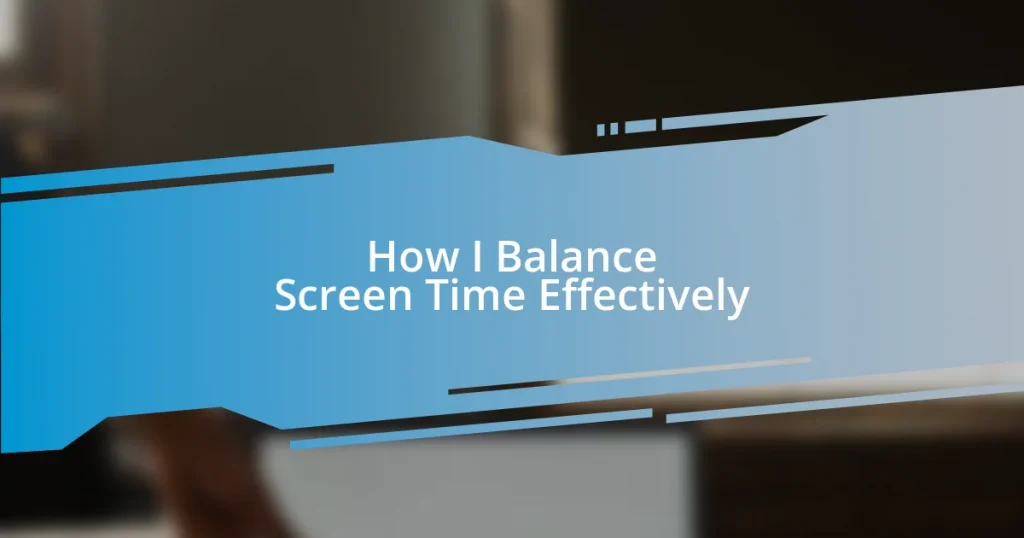Key takeaways:
- Excessive screen time can negatively impact mental well-being, leading to issues such as anxiety and disrupted sleep, highlighting the need for balance in digital engagement.
- Setting flexible screen time goals for work, leisure, and socializing helps prioritize meaningful activities and creates a healthier relationship with technology.
- Regular monitoring and self-reflection on screen usage promote intentional screen time, encouraging a focus on enriching activities over mindless scrolling.

Understanding screen time impact
Understanding the impact of screen time is more complex than simply counting hours. I once found myself glued to my phone during a family dinner, and I realized how disconnecting it felt, even amidst loved ones. Has this ever happened to you? That moment made me appreciate how excessive screen engagement could unintentionally inhibit quality interactions and create emotional distance.
Research highlights that too much screen time can lead to issues like anxiety and disrupted sleep. I remember a period when I was binge-watching late into the night, which led to grogginess the next day. It’s easy to dismiss how digital content can influence our mental well-being, but reflecting on my experience, I’ve come to understand that balance is key.
Moreover, the effects vary with the nature of screen use. For example, scrolling through social media can amplify feelings of inadequacy while engaging in educational content can be enriching. Have you noticed how different types of screen time affect your mood? For me, prioritizing productive and positive screen activities has transformed my overall experience and helped me maintain a healthier balance.
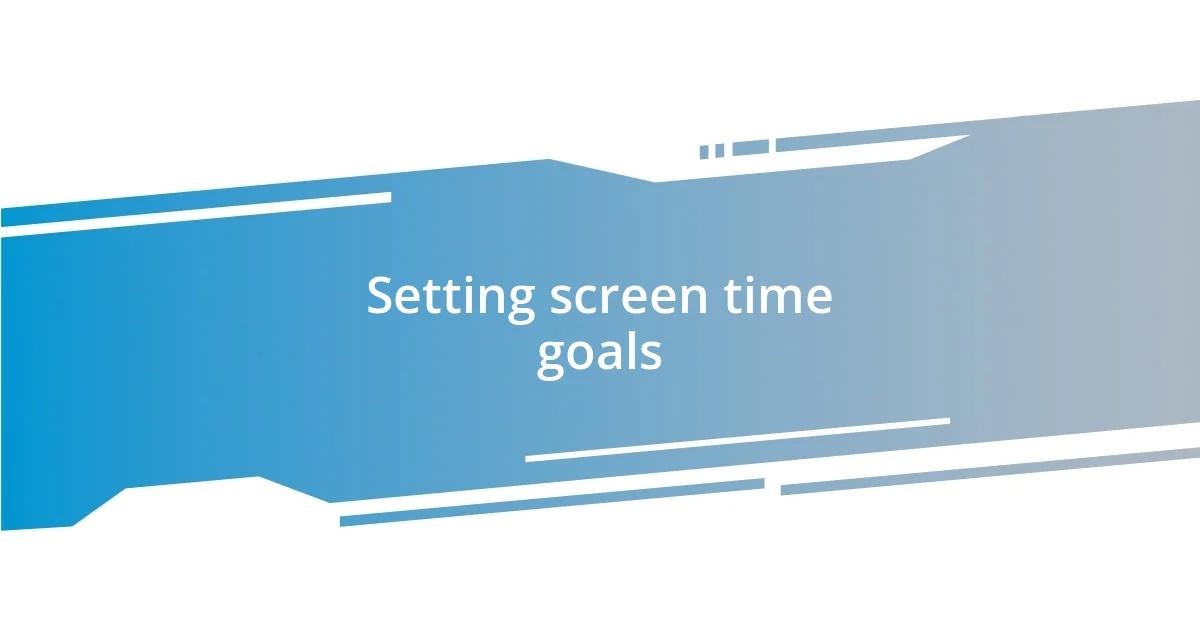
Setting screen time goals
Setting screen time goals is an essential step in achieving a healthy balance with technology. I recall setting limits for myself after realizing I was mindlessly scrolling through apps instead of enjoying hobbies I once loved. Establishing specific goals helped me prioritize activities that truly matter and added value to my life.
When I first started, I focused on allocating time for both leisure and productivity. For instance, I set a goal of one hour for social media and two hours for reading each week. Not only did this help me regain control, but I also found more joy in activities that previously took a backseat to screen time. By measuring what I aimed to achieve, I could adjust my habits, finding that a mindful approach made all the difference.
It’s important to remember that setting these goals should be flexible. I learned this the hard way when I strictly adhered to a rigid schedule, which led to frustration rather than improvement. Instead, I prefer setting adaptable, achievable goals that allow for spontaneity. By recognizing what works best for me and allowing room for adjustments, I’ve turned screen time management into a more gratifying journey.
| Goal Type | Description |
|---|---|
| Work-related | Limit time on screens to focus on task-oriented activities. |
| Leisure | Set aside specific hours for engaging with entertaining content. |
| Social | Designate time for connecting with friends and family online. |
| Learning | Allocate screen time to educational resources or courses. |
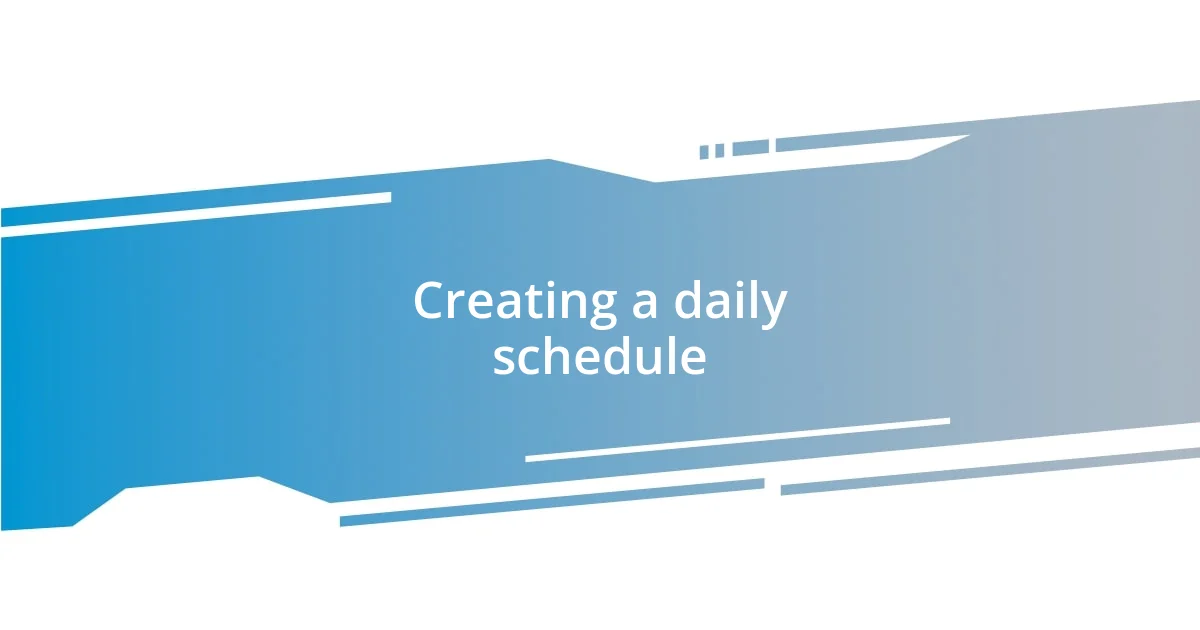
Creating a daily schedule
Creating a daily schedule has been crucial in managing my screen time effectively. I found that simply tracking the hours didn’t yield the balance I desired. Instead, I started mapping out my day, intentionally designating time blocks for work, leisure, and socializing. For instance, I remember scheduling specific periods for work-related tasks, so I wouldn’t fall into the trap of scrolling during a break without purpose. By doing this, I not only maintained focus but also felt accomplished at the end of the day.
Here are some strategies that helped me create an effective daily schedule:
– Morning Routine: I prioritize tech-free activities like reading or exercise to start my day positively.
– Work Clarity: I block out uninterrupted work sessions, often using tools like timers to keep myself accountable.
– Leisurely Breaks: I set aside time for binge-watching my favorite shows, ensuring it’s a reward, not a default activity.
– Connection Time: I earmark evenings to connect with friends virtually, which keeps my social life vibrant.
– Reflection Period: I added a quick review at the end of the day, assessing how well I stuck to my schedule and what adjustments might be needed.
In creating this daily structure, I’ve learned to balance my screen time thoughtfully, allowing me to cultivate a healthier relationship with technology and myself.
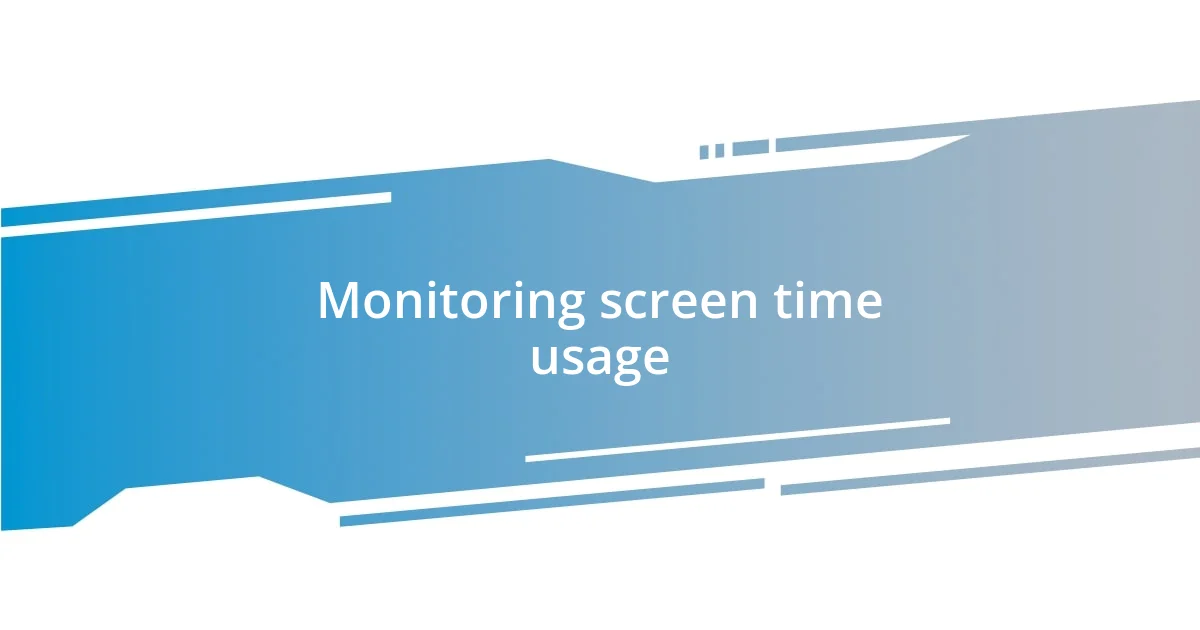
Monitoring screen time usage
Monitoring screen time usage is something I’ve had to embrace to truly understand my habits. Initially, I was shocked to see just how many hours I spent staring at screens daily. This awareness pushed me to leverage apps that track and report my usage, giving me a firsthand look at my daily digital footprint, which was both eye-opening and motivating.
One evenings, after checking my screen time report, I realized I had unwittingly spent nearly four hours on my phone. I questioned, “Is this really how I want to spend my free time?” That moment of clarity prompted me to set up alerts for when I’d hit my designated limits, preventing the mindless scrolling that had become second nature. Now, those notifications serve as gentle reminders to step away, prompting me to choose more fulfilling activities instead.
I also find value in weekly reflections on my screen habits. Each Sunday, I look back at my usage patterns and ask myself if they align with my life goals. This simple practice has transformed my approach. For example, one week I noticed I was spending far too much time on news apps, which was fueling anxiety rather than providing information. Adjusting my usage accordingly became essential. Monitoring isn’t just about cutting back; it’s about finding a healthier balance that enriches my life.
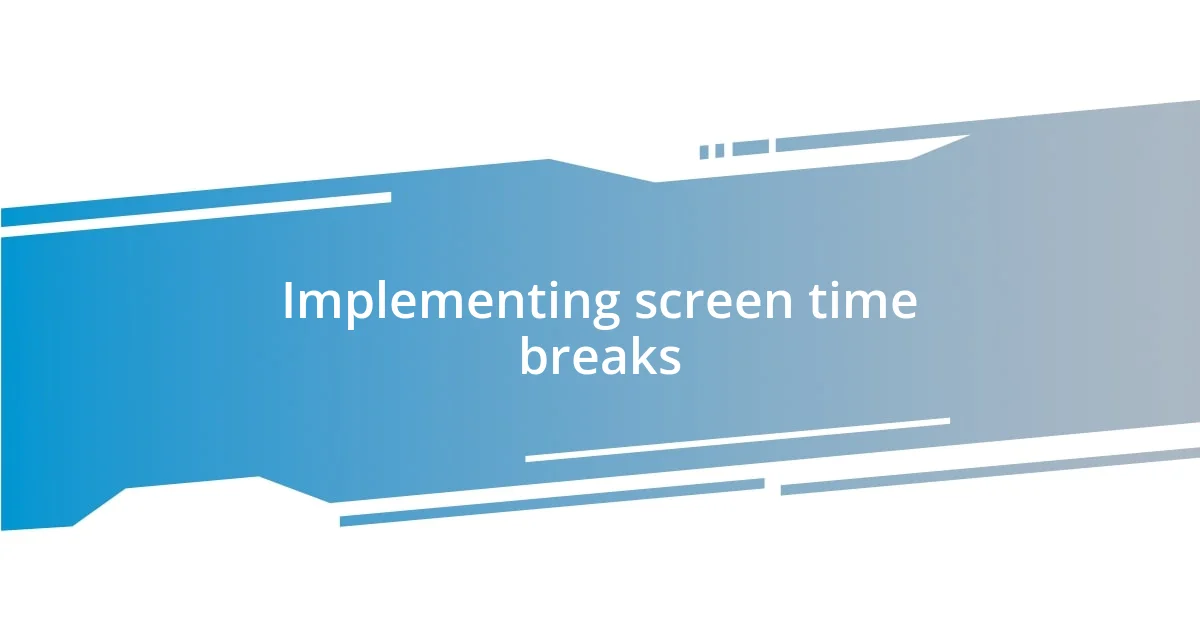
Implementing screen time breaks
Implementing screen time breaks has been a game-changer for me. I vividly remember the first time I set a timer for a break after forty minutes of focused work; it was surprisingly refreshing. Taking just five to ten minutes to stretch, grab a snack, or step outside brought an undeniable sense of rejuvenation. I often ask myself, “How am I supposed to maintain my energy and focus if I don’t give my mind a breather?” This simple practice has transformed my productivity.
I’ve found that changing the environment during breaks can make a world of difference. When I step away from my desk to walk around or even just to sit on my balcony, I notice the shift in my mindset. It’s as if the physical change helps reset my mental state. Just last week, after a few back-to-back virtual meetings, I decided to take my break outdoors. The fresh air and sunlight completely lifted my spirits, and I returned to my tasks feeling more energized than ever. These little breaks provide clarity; they remind me that life exists beyond the screen.
Moreover, I’ve learned to incorporate creative activities into my breaks. Sometimes, I grab a sketchbook and doodle, while other times I play with my dog or listen to music. These moments allow me to reconnect with my passions, which screen time often overshadows. It makes me wonder: how can something as simple as a break unlock a wave of creativity? And yes, it absolutely does! By allowing these regular pauses, I’ve not only improved my focus but also brought more joy and inspiration into my daily routine.
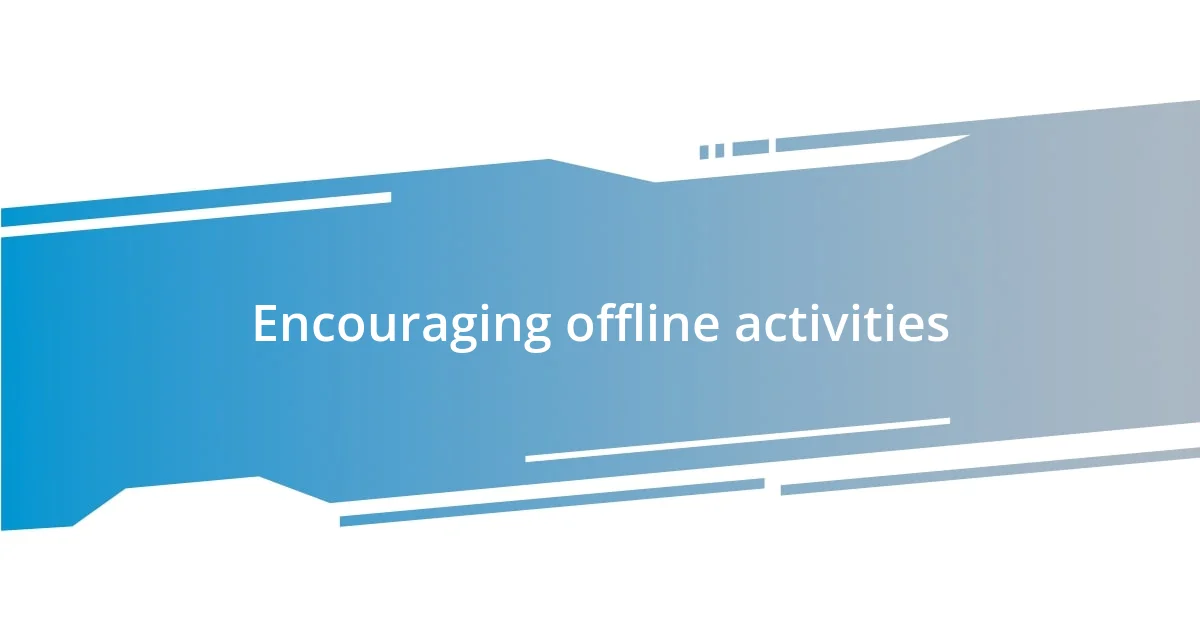
Encouraging offline activities
There’s something incredibly refreshing about stepping away from screens and diving into offline activities. I remember a particular Saturday morning when I decided to leave my phone behind and explore my local park. The simple act of being surrounded by trees and enjoying the chirping of birds filled me with a peace that so much screen time had masked. I often wonder, why don’t more people embrace these moments of stillness and simplicity?
Engaging in hobbies like painting or gardening has also been a delightful antidote to excessive screen time. Just recently, I took up painting. The process of mixing colors and applying them to canvas felt liberating. It’s as if each brushstroke drew me into the present moment. I realized how easy it can be to lose track of time in creative pursuits. How often do we give ourselves permission to be messy, to create without the pressures of likes and shares?
Moreover, family game nights have become a cherished tradition in my home. We gather around the table, laugh, and play board games that spark connections and memories, far removed from the digital world. It’s incredible how unplugging for a few hours can strengthen our bonds and create lasting experiences. I ask myself, why wouldn’t we prioritize these joyful moments? The truth is, the laughter and conversations we share during these times are moments I’d never trade for a screen. By encouraging offline activities, I find myself leading a more balanced, enriching life.
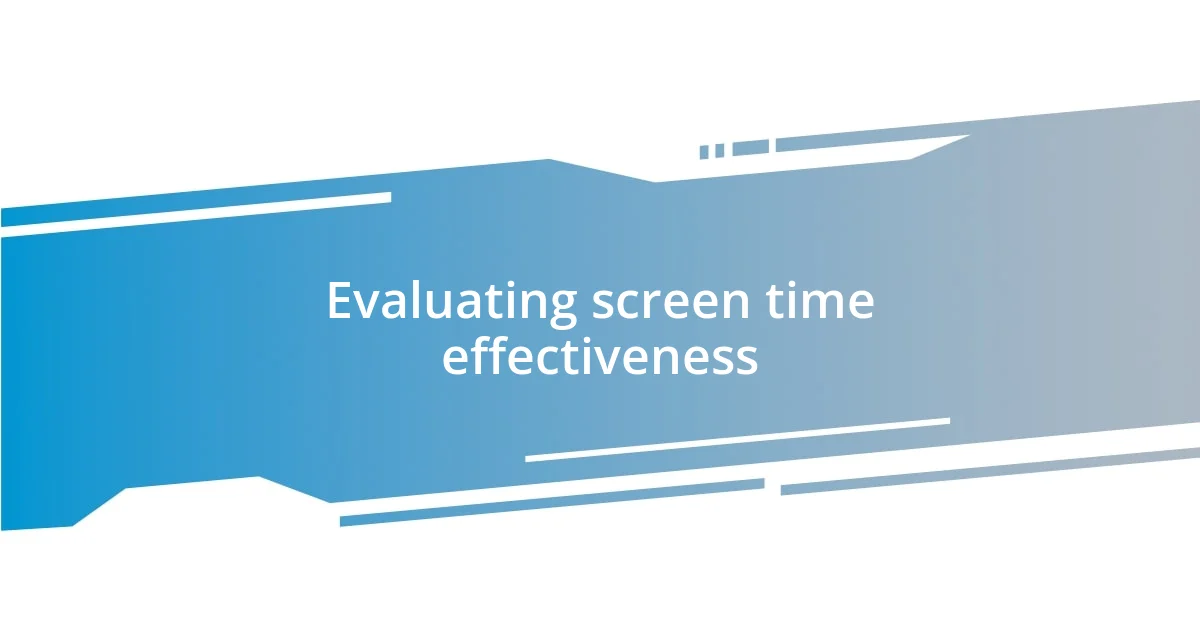
Evaluating screen time effectiveness
Evaluating the effectiveness of screen time is essential for understanding how it impacts my daily life. I often take a moment to reflect on how my screen activities contribute to my overall well-being. For instance, after a long day of back-to-back video calls, I check in with myself: “Did that really energize me, or do I feel drained?” This self-assessment helps me discern productive use versus mindless scrolling.
I’ve discovered that not all screen time is created equal. Some evenings, I find myself engrossed in an educational webinar that leaves me inspired and eager to learn more. On other nights, however, I can easily fall into the trap of endless social media browsing, which often leads to feelings of comparison and frustration. By asking myself how each experience makes me feel, I can better identify which screen activities enrich my life and which ones deplete my energy.
Tracking my screen time has become a valuable practice as well. I recently started using an app to monitor how long I spend on various platforms. At first, I was shocked by the numbers, especially the time spent on entertainment versus purpose-driven activities. After adjusting my habits, I find joy in more intentional screen time that feeds my passions, like watching cooking tutorials or exploring documentaries. This evaluation process encourages me to make conscious choices, and I can’t help but wonder: how much more fulfilling could my daily routine be if I prioritize content that truly sparks joy?











